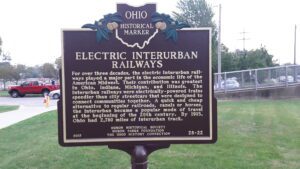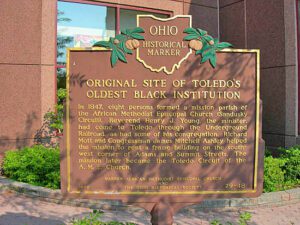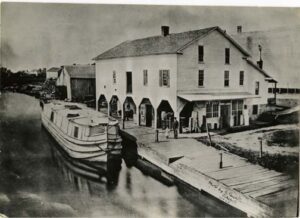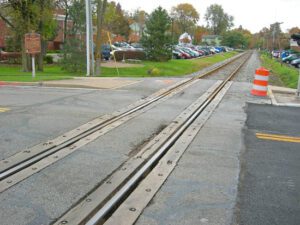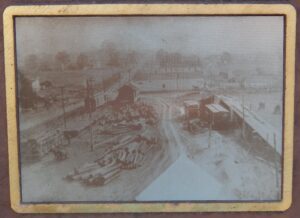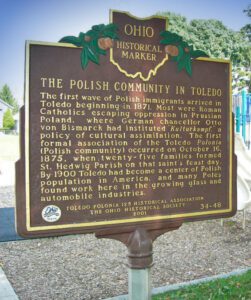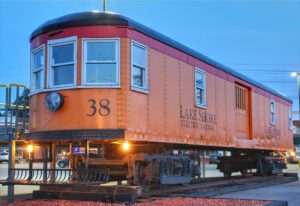, OH
For over three decades, the electric interurban railways played a major part in the economic life of the American Midwest. Their contribution was greatest in Ohio, Indiana, Michigan and Illinois. The interurban railways were electrically-powered trains speedier than city streetcars that were designed to connect communities together. A quick and cheap alternative to regular railroads, canals or horses, the interurban became a popular mode of travel at the beginning of the 20th century. By 1915, Ohio had 2,780 miles of interurban track.
, OH
In 1847, eight persons formed a mission parish of the African Methodist Episcopal Church (Sandusky Circuit). Reverend Henry J. Young, the minister, had come to Toledo through the Underground Railroad, as had some of his congregation. Richard Mott and Congressman James Mitchell Ashley helped the mission to rent a frame building on the southwest corner of Adams and Summit streets. The mission later became the Toledo Circuit of the A.M.E. Church.
, OH
The Wabash & Erie Canal opened between Toledo and Lafayette, Indiana, May 8, 1843. The Miami Extension Canal was completed to Junction, Ohio, on July 4, 1845, linking the Wabash & Erie Canal with Cincinnati and resulting in changing the canal’s name to the Miami and Erie Canal. Prosperity reigned until the 1850s when railroad competition caused a slow decline in commerce. The canal branch to Indiana was in disuse by 1858 and totally abandoned in 1888. The canal system was revived from 1906-1909 with much reconstruction and improvement only to be badly damaged by severe statewide flooding in 1913. The canal was maintained from here to Maumee for generating hydro-electric power until it was drained in 1929. Twelve miles of canal and the Maumee Side Cut Canal have been leased to the Toledo Area Metroparks since 1932.
, OH
This rail line was the original route of the Erie and Kalamazoo Railroad, the first railroad to operate west of the Allegheny Mountains. The train made its initial run on October 3, 1836 from Toledo to Adrian, a total of approximately thirty miles. In 1837, a steam locomotive replaced horses as the train’s engine. The E. & K. R.R. opened markets from Lake Erie to the Michigan Territory.
, OH
The earliest improved public road west from Lake Erie to the Indiana border, the Territorial-Indiana Road was built by the U.S. Government in 1834-1835 through the Cottonwood Swamp, then a major obstacle to travel. It ran parallel to the Harris Line, the northern boundary of a narrow strip of land contested by Ohio and Michigan from 1803 until 1836, when Ohio annexed it following the “Toledo War.” Completion of the 110-mile road gave farmers and settlers much improved access to markets and new western lands. It became the Indiana Plank Road in 1848 and later Sylvania-Metamora Road. The Toledo and Western Electric Railway’s parallel right-of-way was completed in 1902.
, OH
The first wave of Polish immigrants arrived in Toledo beginning in 1871. Most were Roman Catholics escaping oppression in Prussian Poland, where German chancellor Otto von Bismarck had instituted “Kulturkampf,” a policy of cultural assimilation. The first formal association of the Toledo Polonia (Polish community) occurred on October 16, 1875, when twenty-five families formed St. Hedwig Parish on that saint’s feast day. By 1900 Toledo had become a center of Polish population in America, and many Poles found work here in the growing glass and automobile industries.
, OH
From the 1890s to the 1930s, interurban railways were an important form of travel in the Midwest. Beach Park Station had an interurban carhouse, where repairs were performed and passengers boarded. The Lorain & Cleveland Railway (L&C) built the 65½ by 200 foot brick station in 1897. By 1901, the L&C became part of the Lake Shore Electric Railway (LSE) and Beach Park became stop 65 on a line that ran from Cleveland to Toledo and then to Detroit. Requiring power and water, the LSE built an electric plant and water tower at Avon Lake. This infrastructure spurred the community’s development and growth. (Continued on other side
, OH
The Lima and Toledo Traction Company Bridge was construted in 1907 by the National Bridge Company of Indianapolis, and it was considered to be a revolutionary type of bridge construction. The Old Electric Bridge, as it was called, was built of steel reinforced concrete and filled with earth. In fact, for this period some considered the bridge to be the longest such railroad bridge in the world. Twelve spans of Roman aqueduct architectural design anchor the 1220-foot bridge in solid river bedrock. The bridge linked Lucas and Wood counties and connected a busy Toledo with points south by means of an electric trolley. This Interurban Bridge was placed on the National Register of Historic Places in 1972.


